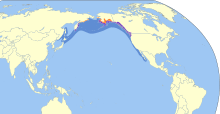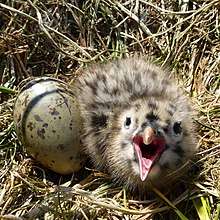Glaucous-winged gull
The glaucous-winged gull (Larus glaucescens) is a large, white-headed gull. The genus name is from Latin Larus which appears to have referred to a gull or other large seabird. The specific glaucescens is New Latin for "glaucous" from the Ancient Greek, glaukos.[2] English "Glaucous" denotes a bluish-green or grey colour.[3]
| Glaucous-winged gull | |
|---|---|
 | |
| Scientific classification | |
| Kingdom: | Animalia |
| Phylum: | Chordata |
| Class: | Aves |
| Order: | Charadriiformes |
| Family: | Laridae |
| Genus: | Larus |
| Species: | L. glaucescens |
| Binomial name | |
| Larus glaucescens (Naumann, 1840, North America) | |
 | |
Range and lifespan
The glaucous-winged gull is rarely found far from the ocean. It is a resident from the western coast of Alaska to the coast of Washington. These glaucous winged gulls can also lived in Seattle area. It also breeds on the northwest coast of Alaska, in the summertime and in the Russian Far East. During winter, they can be found along the coast of California, Oregon, Baja California, Baja California Sur, and Sonora. It frequently hybridizes with western gull resulting in identification problems—particularly in the Puget Sound area. This species also hybridizes regularly with the herring gull in Alaska. Both hybrid combinations resemble the Thayer's gull. Glaucous-winged gulls are thought to live about 15 years, but some live much longer; a bird in British Columbia, for example, lived for more than 21 years,[4] while one in the US state of Washington, lived for at least 22 years, 9 months.[5] The longevity record though, is more than 37 years, for a bird banded as a chick in British Columbia.[6]
It is an exceptionally rare vagrant to the Western Palearctic region, with records from Morocco, the Canary Islands and, most recently, from Ireland in February and March 2016. It has also been recorded in Britain in the winters of 2006/2007 and 2008/2009. The 2008/2009 record was from Saltholme Pools, Cleveland, and attracted hundreds of twitchers.
Description

This gull is a large bird, being close in size to the herring gull, with which it has a superficial resemblance, and the western gull, to which it is likely most closely genetically related. It measures 50–68 cm (20–27 in) in length and 120–150 cm (47–59 in) in wingspan, with a body mass of 730–1,690 g (1.61–3.73 lb).[7][8][9] It weighs around 1,010 g (2.23 lb) on average.[8] Among standard measurements, the wing chord is 39.2 to 48 cm (15.4 to 18.9 in), the bill is 4.6 to 6.4 cm (1.8 to 2.5 in) and the tarsus is 5.8 to 7.8 cm (2.3 to 3.1 in).[9] It has a white head, neck, breast, and belly, a white tail, and pearly-gray wings and back. The ends of its wings are white-tipped. Its legs are pink and the beak is yellow with a red subterminal spot (the spot near the end of the bill that chicks peck in order to stimulate regurgitative feeding). The forehead is somewhat flat. During the winter, the head and nape appears dusky, and the subterminal spot becomes dark. Young birds are brown or gray with black beaks, and take four years to reach adult plumage.
The glaucous-winged gull nests in the summer, and each pair produces two or three chicks which fledge at six weeks.
It feeds along the coast, scavenging for dead or weak animals, fish, mussels and scraps. In urban areas it is well known for its tendency to accept food from people and peck open unprotected garbage bags in search of edibles. Its cry is a low-pitched "kak-kak-kak" or "wow", or a more high-pitched wailing.
References
- BirdLife International (2012). "Larus glaucescens". IUCN Red List of Threatened Species. 2012. Retrieved 26 November 2013.CS1 maint: ref=harv (link)
- Jobling, James A (2010). The Helm Dictionary of Scientific Bird Names. London: Christopher Helm. pp. 174, 219. ISBN 978-1-4081-2501-4.
- "Glaucous". Oxford English Dictionary (3rd ed.). Oxford University Press. September 2005. (Subscription or UK public library membership required.)
- Campbell, R. Wayne (Spring 1975). "Longevity Record of a Glaucous-winged Gull" (PDF). Journal of Field Ornithology. 46 (2): 166. doi:10.2307/4512116.
- Klimkiewicz, M. Kathleen; Futcher, Anthony G. (Autumn 1989). "Longevity Records of North American Birds" (PDF). Journal of Field Ornithology. 60 (4): 469–494.
- Campbell, R. Wayne (June 2007). "New Longevity Record of a Glaucous-winged Gull from British Columbia". Wildlife Afield. 4 (1): 78–80.
- All About Birds (2011).
- CRC Handbook of Avian Body Masses by John B. Dunning Jr. (Editor). CRC Press (1992), ISBN 978-0-8493-4258-5.
- Gulls: Of North America, Europe, and Asia by Klaus Malling Olsen & Hans Larsson. Princeton University Press (2004). ISBN 978-0691119977.
Further reading
Identification
- King, Jon (2007) Identification of Glaucous-winged Gull: a photo-gallery Birding World 20(2):64-72
External links
| Wikimedia Commons has media related to Larus glaucescens. |
- Detailed year-to-year plumage of the glaucous-winged gull
- Glaucous-winged gull at Animal Diversity Web
